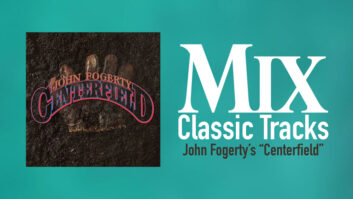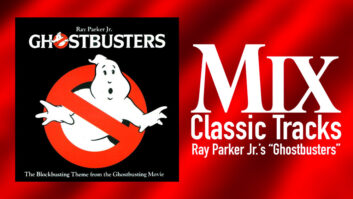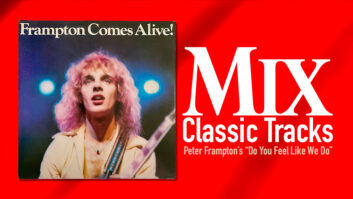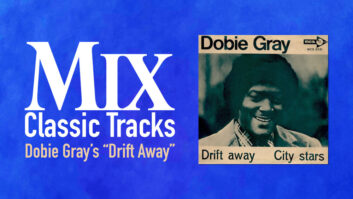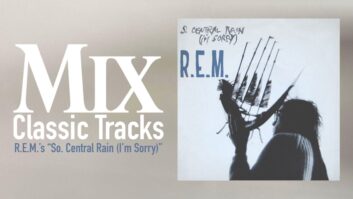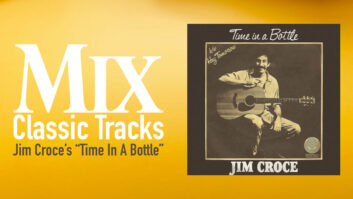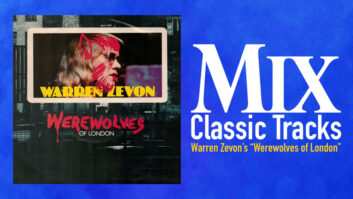
The year 1969 was a hot one for Creedence Clearwater Revival. The San Francisco Bay Area group had burst onto the scene the summer before with its self-titled LP, and followed up with three more albums the next year: Bayou Country (featuring the huge hit “Proud Mary,” which placed CCR on the road to success), Green River and Willy and the Poor Boys. The group was in its prime.
Creedence had been recorded by Walt Payne at Coast Recorders in San Francisco, and Bayou by Hank McGill at RCA Studios in L.A. But Green River brought CCR to a new San Francisco studio, Wally Heider Recording (now Hyde Street Studios). Heider already had a successful studio in the heart of Hollywood — his original facility at Selma Avenue and Cahuenga Boulevard — but by the end of 1968, he had decided to expand northward to service the burgeoning recording market in the San Francisco Bay Area.
 That same year, Heider hired a 27-year-old musician and self-taught engineer named Russ Gary, though that was not Gary’s introduction to the studio. Three years prior, Gary’s Long Beach band, Lloyd Terry & The Victors, had done a session at the L.A. facility. “Wally himself was the engineer,” Gary recalls. Gary had actually begun recording in his own garage, like many budding engineers. “I started getting pretty good and getting more little pieces of homemade equipment. I never had any equalization, but I did buy a few good microphones.” Not long after, he got a job (working for free) in Santa Ana, Calif., with former Gold Star mixer George Fernandez at his studio, United Audio Recording. Eventually, Gary made his way to Heider’s place, working as a second engineer alongside such mixers as Bones Howe and Chuck Britz on records for such artists as the Fifth Dimension, The Association and Waylon Jennings.
That same year, Heider hired a 27-year-old musician and self-taught engineer named Russ Gary, though that was not Gary’s introduction to the studio. Three years prior, Gary’s Long Beach band, Lloyd Terry & The Victors, had done a session at the L.A. facility. “Wally himself was the engineer,” Gary recalls. Gary had actually begun recording in his own garage, like many budding engineers. “I started getting pretty good and getting more little pieces of homemade equipment. I never had any equalization, but I did buy a few good microphones.” Not long after, he got a job (working for free) in Santa Ana, Calif., with former Gold Star mixer George Fernandez at his studio, United Audio Recording. Eventually, Gary made his way to Heider’s place, working as a second engineer alongside such mixers as Bones Howe and Chuck Britz on records for such artists as the Fifth Dimension, The Association and Waylon Jennings.
By late 1968, Heider was ready to staff his new Bay Area facility, which was to have been headed by staff engineer Rik Pekkonen. When Pekkonen declined to relocate, Gary volunteered to go, working under his old boss George Fernandez. “I did what I could to help get the place wired, helping Frank DeMedio get the place ready,” Gary says. DeMedio was a key player in the design of the studio; he and Heider were alumni of Bill Putnam’s United/Western Studios (now Ocean Way). Within a few months, however, Fernandez and Heider parted ways, and Gary was promoted to full recording engineer.
Though he recorded a few smaller bands, a month after his promotion, in March 1969, Gary and the studio had a visit from John Fogerty, who gave the facility the once-over and booked a demo session. “I guess he wanted to see if I, and the studio, made the grade,” says Gary.
The engineer was more than happy to be recording Fogerty’s brand of swampy rock. “I’m a Southern boy,” says the native Virginian. “I’m a countrified rock ‘n’ roller. I was right at home. Those guys played the music I really liked.”
The single three-hour session resulted in two instrumental recordings, “Glory Be” and “Briar Patch.” “I did a quick mix, and they took off, and I didn’t know if I’d see them again,” he says. But shortly thereafter, the group booked time and recorded a pair of tracks for their next single, “Green River” and “Commotion,” followed, after a brief break, by sessions for the remainder of the Green River album.
Green River was a huge hit, making it to the top of charts, with “Bad Moon Rising,” “Lodi” and the title track leaving their marks. Shortly after release, it was back to Heider’s to record Willy and the Poor Boys. Released in November 1969, the album reached Number 3 on the Billboard Pop Albums chart, as did its catchy lead track single, “Down on the Corner.”
But it was “Fortunate Son,” which peaked at Number 14, that truly captured some of the intense emotions of the times. The song became an anthem for countless young people of the era, resentful of the Vietnam War and of the further injustices between classes — it’s told from the perspective of a young man who doesn’t have the connections to stay out of the military.
“Fortunate Son,” like the rest of the album, was recorded in a manner Gary and producer Fogerty had nailed down during the previous album’s sessions, cementing the Creedence sound for good. “In my opinion,” Gary says, “Willy and the Poor Boys is the most consistent album, technically, of all of them. As a friend of mine says who has mastered the album, they just ran it.”
The first part of the process, of course, was rehearsing. “More than anybody else, they had the tunes together when they came over,” Gary notes. “They rehearsed every day. Then, when they came to record, they had it. We had albums done in two-and-a-half weeks.”
The bandmembers lived in the East Bay and they rehearsed in an industrial area of Berkeley in a large industrial building that drummer Doug Clifford nicknamed “Cosmo’s Factory.” (It’s the rehearsal area of that 22,000-square-foot building that is pictured on the cover of the album that bears that name.) The building later became home to a studio, DSR, which Gary created along with Clifford and CCR bassist Stu Cook.
Fogerty also rehearsed at home, with a small recording system Gary had helped assemble. “I’m sure he even rehearsed the tape delays because he had machines that had the same head gap as the Ampex recorders at Heider,” Gary says.
Once ready, the group assembled across the Bay in Studio C at Heider’s — their home, with rare exception, for the remainder of their recording career. “That was a good room,” Gary recalls. “You could put a lot of instruments in there and you didn’t have to worry about baffling.”
Gary set up his mics in a consistent manner, one that Fogerty took to immediately from the first “Green River” session. “He came in, I got everything miked up and listened to them play a little bit, then John came into the booth and we went through it. My approach was not to add any EQ; just bring it up and go from there.”
The main workhorse mic for Gary’s Creedence sessions was the Shure SM56, which was applied to nearly every instrument and, on one occasion only — the “Green River” single — to Fogerty’s vocal. “Those were nice mics,” the engineer notes, “because they had a natural peak at around 2k or 4k. I don’t know why, but that mic made instruments sparkle a little bit without funny EQ.”
Gary placed an SM56 on both Fogerty’s guitar amp (alternately a Kustom or tweaked Fender Vibrolux) and on brother Tom Fogerty’s Kustom. “I’d use close-miking — not directly in the center of the cone, but off, just so it wouldn’t be so trebly,” he says. Cook’s bass was recorded direct and with an SM56 on the speaker cabinet.
Each piece of Clifford’s Camco drum kit was also miked with an SM56, though the snare required a second mic, a Sony C37 condenser. “Doug used a big Camco snare. It was a big wooden snare, and the rattles were so far down below that the mics could barely hear it. By the time we got to Cosmo’s Factory, I did start putting an SM56 underneath the snare to get some more of the rattles in.” At Fogerty’s request, the snare was recorded through one of Heider’s echo chamber returns — from Chamber 4, Gary’s favorite. “I printed the return right in with the snare,” he says. “If we wanted something and we knew it was right, we’d do it.”
Classic Tracks: Hall & Oates “I Can’t Go For That (No Can Do)”
Another unique part of the CCR drum sound was Clifford’s large-diameter hi-hat. “That was an 18-inch hi-hat,” Gary says. “I’ve never recorded anyone who used cymbals that large. And if you hear Doug and Stu play with their band today, you can really tell that identifying sound between those guys.” Gary placed a Sony C37A on the crash and a U87 on the ride. Another U87 was placed about six feet behind the drum kit for ambiance. “When you’re close-miking, everything sounds real up-front. Not only did the room mic capture ambiance from the drums, it captured some of the other instruments, as well.”
The mics led to the Frank DeMedio custom-built recording console. “That thing was built like a tank,” Gary recalls. “It was just a beautifully made board. The harnesses were like the Golden Gate Bridge, it was made so well.” The desk was built with Universal Audio components, including UA 550 rackmount equalizer/filter sets normaled to the first eight faders, but otherwise, very little EQ was available on the console. “It had some 5k and some 10k and a little something around 100, and then maybe 50,” a situation both Gary and Fogerty were quite comfortable with. Outboard Lang and Pultec equalizers were available, but rarely used. “When I was recording in my garage, I never had any EQ. I just kind of moved the mics around to get what I was after. So I had that same mindset when I recorded at Heider’s. John worked hard to get the source that the microphones heard sounding really good, so he liked it, as well. There was not a lot of EQ on Creedence music. You just put good microphones out there and put them in the right spot.”
The desk was 24-in, 8-out. “Sixteen-channel machines had not arrived when that console was built, but it was just around the corner, and Frank knew it,” Gary says. With the arrival of 16-track in 1969, additional inputs were simply multed into buses 1 through 8.
For Gary’s first Creedence album, tracks 1 through 8 comprised the rhythm tracks, which were recorded onto a 3M 8-track machine. That was then transferred to 2-inch tape on a 16-track machine to allow for the addition of overdubs. By the time of Willy and the Poor Boys and “Fortunate Son,” however, the studio had switched to recording the rhythm track directly to one of the early MCI 16-tracks, either on Ampex 401 tape or — Gary’s preference — Scotch 201, which “seemed to have a sweeter, brighter top end.”
After the rhythm tracks were completed by the full band, Fogerty would return to furnish his lead vocal and all overdubs — everything from background vocals to piano, tambourines, keyboards and percussion. “Most of the time, he had it in his mind,” Gary says. “A few times, I could tell he was winging it, but he would hear something that he liked and adapt to it.” The band would not be involved in background vocals overdubs, in fact, until Cosmo’s Factory‘s “Who’ll Stop the Rain.”
Gary says that Fogerty was also adept at punch-ins. “He knew how to do it, and you could never tell they were punch-ins. But he didn’t do that many with his vocals. When he sang a keeper track, he really sang it.” Mixing was handled by Gary and Fogerty together. “He was always to my left — I took things on the right, and he took things on the left. But it really wasn’t too hard to mix those pieces, I must tell you. They were recorded well, and it just laid in there real nice.”
As noted, Gary used very little EQ on Creedence recordings — or any other trickery for that matter. “The only EQ I used on the drums was to put a little bit of 10k, maybe 3 dB or of 10k on the ride cymbal, and that was it. It helped brighten it up ever so slightly and still kept the feel.” Background vocals during recording would be recorded with the machine running just slightly slow. “It made them come back a little crisper. Not too much; otherwise, it would sound like The Chipmunks!”
But there was one signature effect that appeared on nearly every Creedence recording. “When we first worked together, John asked, ‘Can you give me some slap-back?’ I said, ‘Yeah, sure.’” Gary had grown up on Elvis and Sun Records recordings, as had Fogerty. Gary achieved the CCR slap using a pair of Ampex 440 2-track machines and the studio’s echo chambers. “During most mixing sessions, both 2-track machines would be running and I would delay the signal going to the chamber to get it slapping and bouncing around, and then there would be one to mix on.”
Once Gary and Creedence started working together, they kept the same working method through five studio albums, with very little change required. “Once the pattern started,” Gary says, “and once I realized the way John wanted to do it, I had it all there and ready to go.”
This Classic Tracks article was first posted March 1, 2009.
